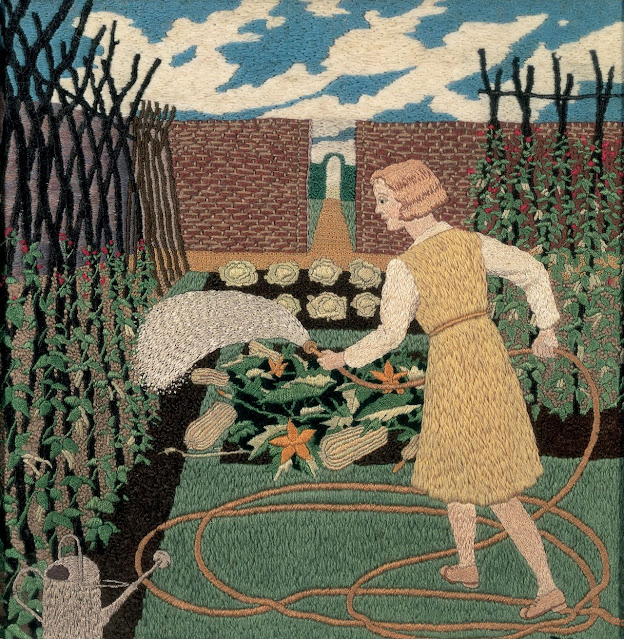| Jamie Luoto, The Swallowing, 2025 (copyright the artist) |
I recently went along to the private view of an exhibition by an artist I'd never heard of, at a gallery I'd never visited before, braving the south London rain to do so and - thanks to a delayed train - having to run to get there before the end. I don't run often, but something about the image of the work sent out in the Kristin Hjellegjerde gallery newsletter forced me to make the effort.
The Swallowing, by American painter Jamie Luoto, shows a naked woman kneeling on a dark polished floor, her body curled around a white mask and her own head invisible. The light that illuminates her skin also throws (or seems to throw) shadows on the curtain behind her, while a glass of white liquid that may or may not be milk hovers in the air above her at a perilous angle. In fact something has already spilt on her, and when we look up from the viscous drips we see the shadow of a dog or wolf, a terrifying animal with saliva dribbling from its snarling mouth. Another, equally fierce beast faces it, menacing the tiny hares which are running around below them, across the hump of shadow cast by the woman's curved back...
The woman's shadow has a tail, which seems to belong to a black cat half-hidden between her body and the curtain. Meanwhile the glossy cherries scattered on the floor in front of her (have they fallen from her hand?) cast their own shadows; one falls on her ankle, marking the skin.
This was the painting that drew me from Hastings on a late-running train, then from London Bridge station in driving rain. I arrived to find the gallery full of people drinking wine and talking animatedly, ie a typical pv scene. The first work I came to showed a dead hare, its back legs suspended in the air, in a circle of cherries. The hare was painted beautifully in the manner of old Dutch still life but with 21st century sensitivity.
| Jamie Luoto, Cherry Hare, 2025 (copyright the artist) |
And there were its tiny shadow-cousins, fleeing giant wolf-dogs in a shadow play that was also perhaps not a shadow play, and there the woman curled protectively around herself on the floor that might be a stage (in a room full of people who were, perhaps, unwittingly playing the role of audience). Yet to learn what had driven Jamie Luoto to make the haunting works in this exhibition, I gazed at the painting, profoundly moved in a way that is hard to describe but which had something to do with feeling-memories of childhood terror and emotional distress - the kind of visceral emotional experience that often seems harder to find in a contemporary art gallery than it in a cinema or a bookshop.
But also at the same time my conscious, critical, art-historically literate self was analysing the work, noting the playful reality shifts between 'real' and 'shadow' worlds, the familiarity of the curled form - picturing a work by Blake or Fuselli that I haven't been able to find and maybe imagined - and more play in the borrowing of hare and cherries from the earlier painting (while a nautilus shell in the corner of another painting seemed to reflect the shape of the curled-up woman in this one), and more still in the theatrical mask (she's playing a role?), and further references: the curtains that reminded me of the David Lynch movie Mulholland Drive; the fairy tale atmosphere evoking Angela Carter, Lotte Reiniger's shadow-play shorts...
Another viewer will come with their own set of references, their own memories, and they will experience this wonderful exhibition 'Shadows of Unseen Grief in their own way. Jamie Luoto's paintings will be on display in Bermondsey until Saturday 11 October, then they will be gone, many to new homes... (not, I'm sad to say, mine!)









